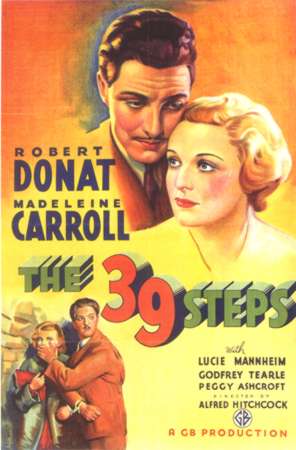The 39 Steps review by Jackass Tom
Engaging enough
It was a quiet Thursday night. I had plans to watch a simple movie; nothing special when it comes to cinema, just a movie. In my possession I have a collection of 10 VHS tapes of old Alfred Hitchcock movies filmed while he was working in Britain. Pre- Hollywood, Pre- David “F’n” O. Selznick. Pre- Rebecca. Of the few I have seen, none has overly impressed me. Most are choppy, and tough to follow at best. Often you see glimpses of the master as he begins to perfect his craft. A splendid opening sequence here, a suspenseful finally there, but none seems to live up to his greats of the 40s and 50s. Along comes the 39 Steps, what I figured to be a valiant effort without much interest. What I found instead was an almost-masterpiece that laid the foundation for many Hitchcock masterpieces soon to follow.
The story is one of Hitch’s most familiar. It falls in the same category as North By Northwest, The Man Who Knew Too Much and Saboteur: movies about bold men who are mistaken for criminals; both hunted by the law and the true criminals. Along the way this ordinary man must do extraordinary things to not only stay alive but bring the real bad guys to justice and clear his own name.
After a scuffle in a vaudeville type theatre that ends with gunshots, Richard Hannay (Robert Donat) finds himself in the presence of a beautiful female spy. She reveals to him who she is, and what she is doing (not typical spy behavior, but it moves the movie along). Trouble comes Hannay’s way when she is found dead in his flat… and so the mistaken crime plot ensues. In order to clear his name, he takes the spy job upon himself, and ventures to Scotland based on bits of information.
His journey is told like a number of short vignettes. First he escapes from the police on the train he boards to Scotland (seen later in North by Northwest). Then he is helped by a grumpy old country farmer and his bored, deprived country wife (glimpses of Torn Curtain). Eventually he makes it to his destination and meets the female spy’s boss… but I don’t want spoil too much of the story. As in most of Hitchock’s thrillers, the ending is predictable, but it’s the way you get there that is so much fun. This movie has all of that.
Even in his early years, Hitch gained the auteur-independence to experiment with many different camera angles (perspective shots, cross cuts, fetishizing shots) and unique uses of sound and timing (in an interview with Francios Truffaut, we find out Hitch did indeed gain enough notoriety to try new and inventive things). There is a short sequence when Hannay gets on a train. The horn blows as he enters a tunnel; this is quickly combined with a shot of a woman screaming at the site of a dead body (the female spy has been found in his flat). Way ahead of his time. On the same train, there are a number of shots where Donat views the rest of the passengers’ and interprets their reactions to him (through a number of perspective shots; behind news papers, from outside at trainstops, etc). As time passes, he grows more and more paranoid as the camera shows the passengers growing more and more suspicious.
Its not just his camera work that Hitchcock is known for, but also his dark and sexual sense of humor. There is a particularly amusing scene where an feminine under-wear salesmen is discussing under-garments while another man is tossing around a newspaper with Hannay’s picture attatched to a murder. Hannay cringe’s in a combination of Freudian guilt (the underwear) and paranoia (as his crime is being waved about). Later in the film he becomes handcuffed to a woman suspecting him of murder (yet love interest) and the two seek refuge from the enemies in a small hotel. To make herself comfortable, she begins rolling down her stockings; meanwhile Hannay is awkwardly wrapped around her naked white legs. Hitch, you naughty devil!
Not only are many of Hitchcock’s later movies influenced by The 39 Steps, but also films such as The Third Man, and Citizen Kane. Many times the plot realism is thrown by the wayside but it is easily forgivable in the name of groundbreaking direction. It’s a great film but the casual HBO watching Vin Diesel fan will find nothing of interest here. This movie is highly recommended for Hitchcock fans, or fans of older black and white noir type films. I haven’t seen it yet, but I would blindly recommend Criterion Collections copy over all else. Because this is an older film, there are a lot of crappy (ie LaserLight-type) copies roaming around with poor sound and picture.
Also for those of you on the cameo watch, I spotted Hitchcock seen 5 minutes in walking past a bus flipping cards. By this time in the 30s he was quite the portly gentleman so look for the big fella.







7 out of 10 Jackasses blog comments powered by Disqus
Search
The 39 Steps

IMDB Link: The 39 Steps
DVD Aspect Ratio: 1.33:1
DVD Extras: Audio Essay, Radio Theatre production, documentary of Hitchcock's British years